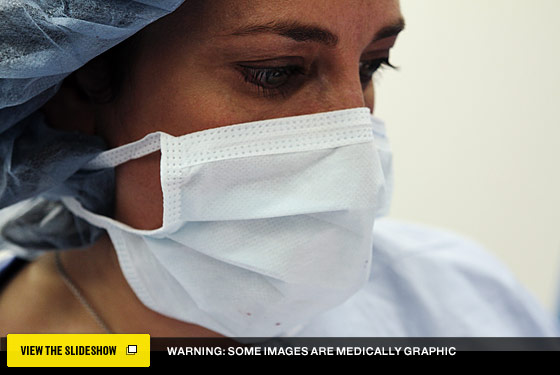
Doctor: Robin Kalish
Specialty: Obstetrics
Location: Weill Cornell Medical Center
Dr. Kalish: The patient is 41 and had been trying to get pregnant for years. As women get older, there are increased risks of complications, but she was a special case: She had a history of huge fibroids, benign tumors of the uterus that cause pain and bleeding. She’d undergone two procedures to remove them. Typically during those procedures, you’ll take out two or three fibroids. But for her second procedure, in 2008, she had more than 30 fibroids removed and developed a lot of scar tissue.
From the beginning, we knew it was going to be a Cesarean. As with most C-sections, the patient was going to be awake for the procedure, which can be scary, especially if all she hears is “We’re having bleeding.” So we gave her updates throughout the surgery.
In a typical case, after you make your incision, you enter into the abdomen. But within a few strokes of the knife, we realized we’d have to remove a lot of scar tissue just to get into her belly. The chief resident and I carefully stripped away the scar tissue connecting her bladder to the uterus. It’s a delicate process. Once we thought we might be home free, we encountered the uterus. It was full of fibroids. So we had to make a vertical incision to deliver the baby, which is very uncommon—you risk having that uterus rupture with the next pregnancy.
The baby came out crying at six and a half pounds, and he and his mother went home just a few days later. She’s a chef. She’s promised to cook me something.
As told to Eric Benson.

In the pre-op room, Dr. Kalish meets with the patient. Photo: Q. Sakamaki/Redux

The patient and her husband share a good-luck kiss as she walks to the operating room. Photo: Q. Sakamaki/Redux

Now in the operating room, Dr. Kalish washes the patient’s belly with an anti-bacterial solution that will minimize the risk of infection. Photo: Q. Sakamaki/Redux

The patient’s husband waits in the pre-op room. Once surgery begins, he’ll join Dr. Kalish and her team in the operating room. Photo: Q. Sakamaki/Redux

The patient and her husband as surgery begins. Photo: Q. Sakamaki/Redux

Dr. Kalish watching carefully as she makes the first incision. Photo: Q. Sakamaki/Redux

The baby emerges from the uterus. Photo: Q. Sakamaki/Redux

The baby was born at a healthy six-and-a half pounds. Photo: Q. Sakamaki/Redux

Dr. Kalish, as she’s handing the baby off to the pediatrician. Photo: Q. Sakamaki/Redux

Dr. Kalish (hands left) sews up the incision on the uterus. The bulges at the top of the uterus are fibroids, benign tumors that cause pain and bleeding. Photo: Q. Sakamaki/Redux

Dr. Kalish removes excess blood inside the abdomen with a laparotomy pad. Photo: Q. Sakamaki/Redux

Dr. Kalish sews up the incision site. Photo: Q. Sakamaki/Redux

Dr. Kalish massages the uterus, which causes it to contract and reduces the amount of bleeding. Photo: Q. Sakamaki/Redux

The surgeon monitors the patient’s vital signs in the recovery room. Photo: Q. Sakamaki/Redux

The new family shares a moment. Photo: Q. Sakamaki/Redux

Photo: Q. Sakamaki/Redux
